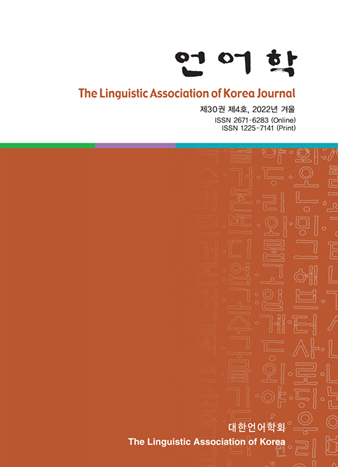대한언어학회 전자저널

30권 4호 (2022년 12월)
- 한국어와 영어 수 단어의 빈도 분포 특성
-
김선회
Pages : 19-40
Abstract
Kim, Sun-Hoi. (2022). The distributional characteristics in the frequency of Korean and English number words. The Linguistic Association of Korea Journal, 30(4), 19-40. The goal of this paper is to identify the distributional characteristics in the frequency of Korean and English number words through quantitatively analyzing their frequency data. The frequency distributions of number words were visualized and the correlation between the magnitude of numbers and the frequency of number words were measured through Spearmans and Kendalls correlation coefficients because the frequency distributions of number words did not follow the normal distribution. This paper shows that the main cross-linguistic characteristics in the frequency of number words, which were reported in Dehaene & Mehler (1992) and Jansen & Pollmann (2001), are also observed in Korean and English: the smaller the number, the more frequent the number words and the local increase effect of reference numbers on the frequency distributions. However, this paper additionally shows that the language-particular number system also affects the frequency distributions of number words.
Keywords
# 기준수(reference number) # 빈도 분포(frequency distribution) # 상관관계 분석(correlation analysis) # 수 단어(number word) # 정규 분포 (normal distribution)
References
- 강범모, 김흥규. (2009). 한국어 사용 빈도. 서울: 한국문화사.
- 윤희수, 이선웅. (2018). 한국어 교육을 위한 수량사구 연구: 말뭉치 분석을 중심으로. 한민족문화연구, 62, 139-172.
- 국립국어원. (1999). 표준국어대사전. 서울: 두산동아.
- Baayen, R. H. (2001). Word frequency distributions. Dordrecht: Springer.
- Clauset, A., Shalizi, C. R., & Newman, M. E. J. (2009). Power-law distributions in empirical data. SIAM Rev, 51, 661-703.
- Davies, M. (2008). The corpus of contemporary American English (COCA). Available online at https://www.english-corpora.org/coca/.
- Davies, M. (2010). The corpus of contemporary American English as the first reliable monitor corpus of English. Literary and Linguistic Computing, 25(4), 447-464.
- Dehaene, S., & Mehler, J. (1992). Cross-linguistic regularities in the frequency of number words. Cognition, 43(1). 1-29.
- Jäger, G. (2012). Power laws and other heavy-tailed distributions in linguistic typology. Advances in Complex Systems, 15(3). 1-21.
- Jansen, C. J. M., & Pollmann, M. M. W. (2001). On round numbers: Pragmatic aspects of numerical expressions. Journal of Quantitative Linguistics, 8(3), 187-201.
- Pollmann, M. M. W., & Jansen, C. J. M. (1996). The language user as an arithmetician. Cognition, 59, 219-237.
- R Development Core Team. (2019). R: A language and environment for statistical computing (Version 3.6.0). http://www.r-project.org.
- Rosch, E. (1975). Cognitive reference points. Cognitive Psychology, 7, 532-547.
- Sigurd, B. (1988). Round numbers. Language in Society, 17, 243-252.